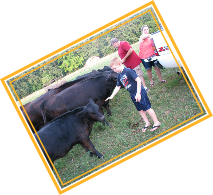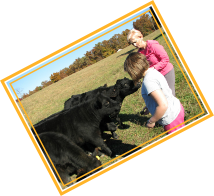
Holtz Country Ranch
1015 Lowery Road
Gilbertsville, KY 42044
(270) 205-0154
Psalm 50: 10 “For every beast of the field is mine, and the cattle upon a thousand hills.”


Grass-Fed Beef and American Aberdeen Angus
American Aberdeen Angus cattle are easy calving, good natured cattle that are very feed efficient and maintain themselves on grass. They have excellent taste, texture and tenderness beef characteristics and exceptional ribeye area per hundred pounds of body weight which translates to very high yielding, high quality, high value beef carcasses.
American Aberdeen cross cattle are extremely well suited to grass-fed beef production as they are easy fleshing and will finish on a high roughage ration, producing high value carcasses with a minimum of input costs.
Average size mature cows generally weigh about 650 to 950 pounds and stand from 36 to 42 inches at the shoulder. Average size mature Lowline bulls weigh from 950 to 1350 pounds and stand from 39 to 46 inches. The average birth weight of fullblood calves is 42 to 48 pounds.
It was important for us to know not only where our food comes from, but also how it is raised. Pasture raised, not confined in a feedlot and without the use of hormones and antibiotics. More importantly we were looking for beef that was consistently tender and tasty. It seemed that supermarket beef just did not taste as good as that raised on the farm, it was either tough, dry and rather tasteless or too fatty.
It's important to remember that grass-fed is not the same as organic. Natural food stores often sell organic beef and dairy products that are hormone- and antibiotic- free. While these products come from animals who most likely were fed less grain than the industry norm, they typically still spent their last months (or in the case of dairy cows virtually their whole lives) in feedlots where they were fed grain. Even when the grain is raised organically, feeding large amounts of grain to a ruminant animal compromises the nutritional value of the resulting meat or dairy products and exacts an added toll on the environment. Our cattle are out on pasture year round. We do not use any type of implants growth hormones or antibiotic supplements. Calves are left with their dams until they are 8-10 months old. They are allowed to mature naturally until their body frame is mature putting down natural marbling rather than packing on the fat with a forced grain diet. This takes time and space. It is not as cost effective as what commercial producers can provide, but it is the best and healthiest beef.
Benefits of Grass-Fed Beef
|
Less total Fat and Calories |
Grain is used to speed growth and add bulk in commercial cattle producing fatter animals.
|
|
More Omega 3 Fatty Acid
|
Omega 3 originates in the green leaves of plants and algae. They are necessary for our health and that our bodies are unable to produce them.
|
|
Less Omega 6
|
Grain is high in Omega 6. Excess omega−6 fatty acids from vegetable oils interfere with the health benefits of omega−3 fats.
|
|
Decreased risk of E. coli
|
Grain makes a cow's digestive tract acidic which promotes the growth of E. coli.
|
|
More
|
Conjugated Linoleic Acid, a potent cancer fighter.
|


